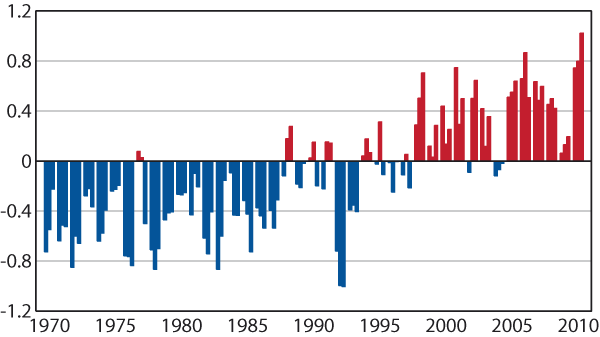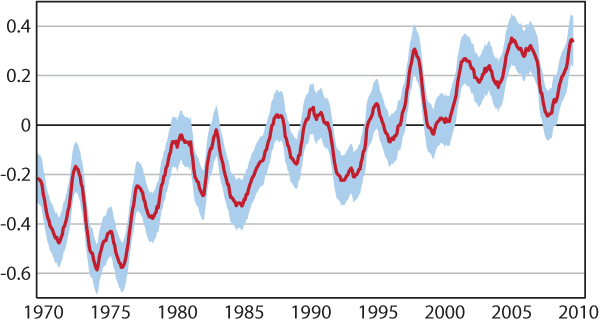

Consistent with widespread media reports of extreme heat and adverse impacts in various places, the latest results from ERA-Interim indicate that the average temperature over land areas of the extratropical northern hemisphere reached a new high in July 2010. May and June 2010 were also unusually warm.

Anomalies in the mean two-metre temperature for May, June and July (deg C), averaged over all land areas north of 20N. Values are from ERA-40 for 1970-1988 and ERA-Interim for 1989-2010 (using pre-release data for June and July 2010). Anomalies are relative to the period 1989-2001 for which both ERA-40 and ERA-Interim data are available.
Temperature anomalies vary from one year to the next because of the natural dynamical variability of the climate system. They may also be influenced for a year or more by cooling due to aerosols from volcanic eruptions such as that of Mt Pinatubo in June 1991. Individual extremes cannot be linked unequivocally to long-term global change, and 12-month averages of global-mean temperatures show marked variability superimposed on an overall warming.
The ERA global average over the 12 months to June 2010 ranks as the second highest on record, insignificantly smaller than the average for the calendar year of 2005. The global anomaly declines slightly in the very latest 12-month average, due to a recent shift toward La Nina conditions in the tropical Pacific and relatively low temperatures over tropical and southern hemispheric land areas, which offset last month’s high northern hemispheric temperatures.

12-month running average of global-mean two-metre temperature anomalies (K) relative to the period 1989-2001. Global averages taken over land and sea are more uncertain than northern hemispheric averages taken only over land; shading is used to indicate an uncertainty range of ±0.1K.
Reanalysis of surface synoptic weather observations, using methods developed for weather prediction, complements traditional monthly climatological records for documenting climate variability and change. A comparison of ERA analyses with analyses based directly on climatological station records was reported earlier this year in the Journal of Geophysical Research (doi:10.1029/2009JD012442). The study was undertaken in collaboration with the Met Office and the Climatic Research Unit of the University of East Anglia.
